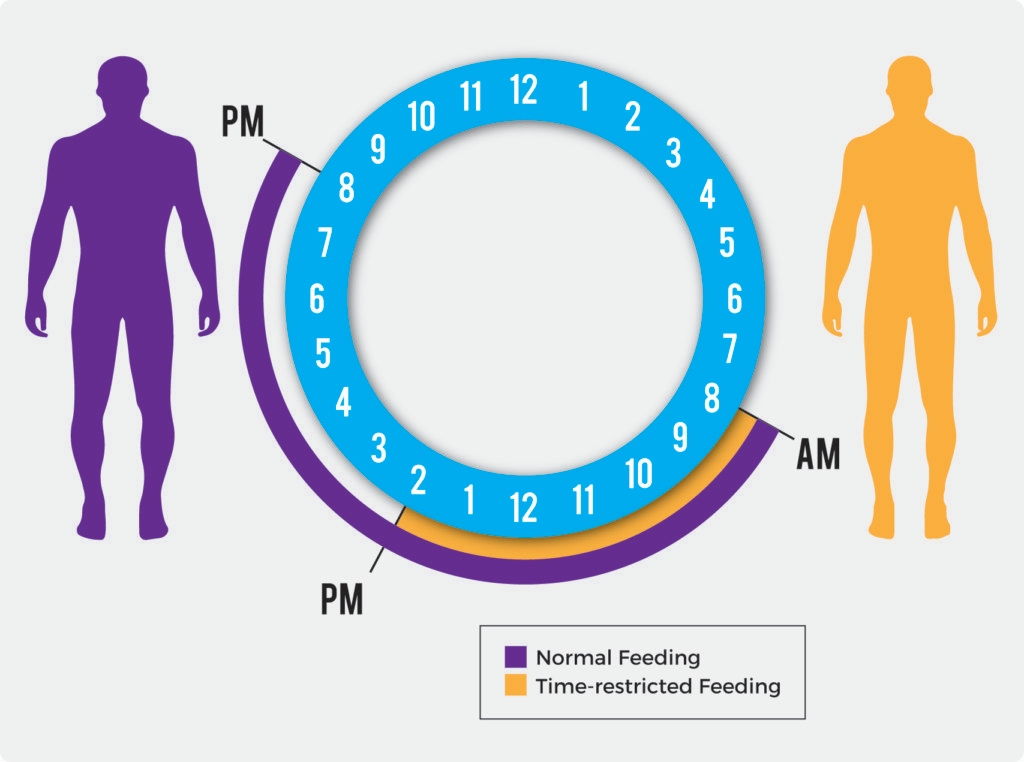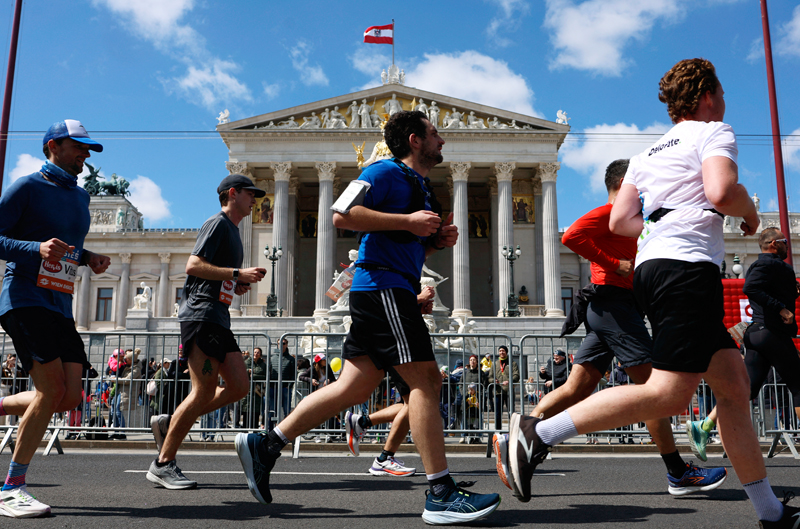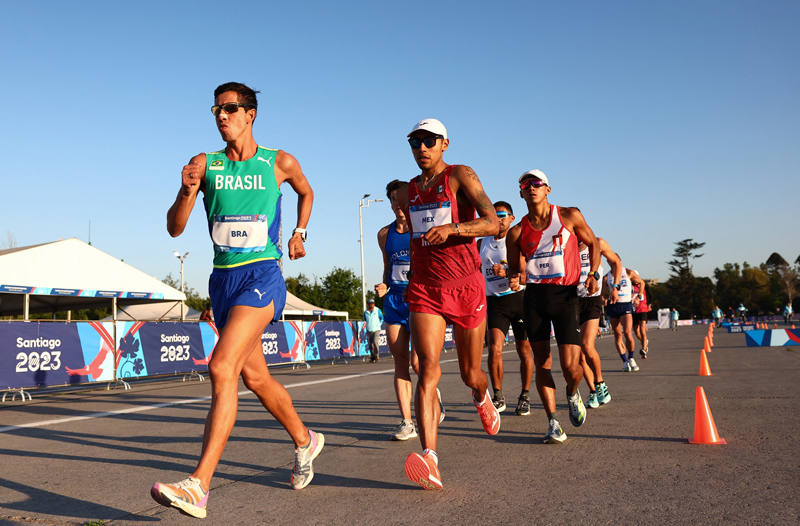You are viewing 1 of your 1 free articles. For unlimited access take a risk-free trial
Weight management: why timing is everything

New research suggests the way you time your daily eating patterns could affect your health, fitness and body fat levels Andrew Hamilton explains...
The old adage ‘Breakfast like a king, lunch like a prince and dine like a pauper’ has long found favour with nutritionists. That’s because as our understanding of nutritional science has grown, we’ve learnt that the way we time our food intake can have a big impact on our health and well being.
For example, a number of studies have shown that eating breakfast in the morning can aid mental function at work or schoolFront Hum Neurosci. 2013 Aug 8;7:425. Likewise, eating last thing at night can lead to poor sleep quality and disturbance to the sleep/wake cycle, which is known to be associated with weight gain and all the health problems that carrying excess weight can lead toCurr Obes Rep. 2014 Mar;3(1):101-7. However, while there’s a lot of truth in this approach, more recent research has thrown up some fascinating findings about how best to time your food intake through the day.
Drawbacks of modern living
Compared to our ancient forebears, 21st century humans have it easy. With modern agricultural practices and no need to hunt and forage for food, most of us have free access to food, 24/7. Now compare our feeding habits to our hunter-gatherer ancestors. Although they managed to sustain themselves, they would have periodically faced periods of famine when food was in scarce supply. Even during periods of relative abundance, there would have been short periods of time – perhaps just a day or two - with no access to food. Today we call this fasting – back then it was just the reality of life! Why are the eating patterns of our ancestors relevant to you and me in 2017? Well, our modern lifestyle, with meals consumed regularly each and every day, is a relatively recent phenomenon in evolutionary terms. Before the advent of modern agriculture (around 12,000 years ago), hunting and gathering was the subsistence strategy employed by human societies across the globe for around 1.8 million years previously. However, because evolution is a very slow process, much of our current genetic makeup remains unchanged from that of our ancient forebears. Back in the distant past, the genetic makeup of humans would have evolved with the need to ensure survival during periods of famine. Indeed, research shows that modern man still carries certain genes evolved to regulate efficient intake and utilisation of fat stores – so-called ‘thrifty genes’. These thrifty genes would have enabled our forebears to burn fat for energy more efficiently, enabling them to forage for food and escape predators even when enduring famine conditions. To put it another way, our metabolic genes may be poorly adapted for a lifestyle of freely available food intake.THE HUMAN TIMELINE
10-40 years ago
- Globalisation
- Foods out of season
- Genetic manipulation
30-60 years ago
- Chemical manipulation of foods
- Prepared foods & fast foods
- Separation from forest and farm
40-80 years ago
- Industrial agriculture
- Pesticides, hormons, CAFOs, mechanization
200 years ago
- Development of modern flour
12,000 years ago
- Development of agriculture
- Grains in the diet
180,000 years ago
- The last major evolutionary shift in humans
- Ability to chase food
1.9 million years ago
- Control of fire
- Cooking of food
Time-restricted feeding
With our ancient genetics in mind, scientists have been carrying out fascinating research on the possible benefits of ‘time-restricted feeding’, where the timing of food intake (not the amount or total calorie intake) is restricted to certain time windows in the day. The theory is that because our metabolism evolved over hundreds of thousands of years when food intake was sporadic, modern human metabolism is still reliant on short periods of limited or no food intake to function efficiently.In a 2016 study, US researchers looked at the metabolic effects of time-restricted feeding (TRF), where access to food is restricted to a few hours in each 24hour period - but without calorie restrictionTrends Endocrinol Metab. 2016 February ; 27(2): 69–83. They concluded that ‘TRF supports robust metabolic cycles and protects against nutritional challenges that predispose to obesity and dysmetabolism’. They went on: ‘The mechanism by which TRF imparts its benefits is not fully understood but likely involves entrainment of metabolically active organs through gut signalling’.
In plain English, restricting the times when you consume food (but not restricting calories) seems to improve the function of your body cells and organs, reducing your risk of obesity and other diseases of metabolism. This seems to occur as a result of positive chemical messages your gut sends out to your organs when it doesn’t have to process food too frequently.
BOX 1: OTHER DIETS TO TARGET THRIFTY GENES
The concept of using diet to target ‘thrifty genes’ in order to enhance fat burning and improve endurance isn’t new. Over the years, a number of nutritional approaches have been proposed with varying degrees of success. These include:BOX 1 OTHER DIETS TO TARGET THRIFTY GENES
| DIET NAME | DESCRIPTION | EVIDENCE FOR BENEFITS | DRAWBACKS |
|---|---|---|---|
| Ketogenic diet | The ketogenic diet (often termed keto) is an almost zero-carbohydrate, highfat diet. It involves drastically reducing carbohydrate intake, and replacing it with fat. The near elimination of carbohydrate puts your body into a metabolic state called ketosis. The rationale is that this forces the body to become very efficient at burning fat for energy. The high % of fat intake and low carbohydrate also promotes the formation of ketones in the liver, which seems to lower blood sugar levels and enhance insulin function. | Increased proportion of energy derived from fat, which can help weight loss. Improved insulin sensitivity, improving outcomes in diabetic patients.Possible benefits in other conditions such as epilepsy and metabolic disease | Switching to a keto diet, usually leads to side effects such as poor energy and mental function, sleep issues, nausea, digestive discomfort and decreased exercise performance.Unless you live and eat alone, difficult to sustain over long periods.Nearly all studies show worse athletic performance compared to diets containing adequate carbohydrate (although not yet properly studied in ultra-endurance athletes). |
| Sleep low | A carbohydrate-fuelled high-intensity training session is performed in the evening, followed by a low-carbohydrate recovery period and overnight fast, which effectively depletes muscle glycogen for the night. The following morning, after a light, lowcarbohydrate breakfast then a prolonged, moderate intensity training session is performed, encouraging glycogendepleted muscles to adapt to burning fat. Carbohydrate intake is not limited but instead restricted at certain times. | Regular sleep-low sessions appear to enhance fat burning AND improve endurance performance | Hunger may be experienced overnight. Dietary approach needs planning within the context of a weekly training schedule. Not recommended for the competitive phase |
| Train low, race high | Periodic training sessions take place in conjunction with a low-carbohydrate diet. Before racing, athletes ensure a highcarbohydrate diet and full muscle glycogen repletion. | Fat burning is enhanced. | No evidence for increased performance.Low-glycogen training is tiring and increases the risk of illness and injury. |
| Fasting | All food intake is stopped for a period of 24 hours or even longer. | Fat burning is enhanced. Regular fasting (2 or 3 days a month) may help reduce weight and the risk of diabetes. | No evidence of increased performance in athletes. Losses of muscle mass, strength and power may occur. |
In the real world
Studying positive changes in metabolism is one thing, but does switching to time-restricted feeding yield benefits in the real world – over and above other methods of targeting thrifty genes? Well, the latest research suggests it does. For the first time in humans, evidence has emerged that eating early in the day lessens daily swings in hunger and changes the 24-hour pattern of fat oxidation and energy metabolism, which may aid in weight loss“Time-Restricted Feeding Study Shows Promise in Helping People Shed Body Fat”. University of Alabama at Birmingham, 6-Jan-2017; article ID: 667254.In the research conducted at the University of Alabama at Birmingham, scientists tried to find out whether changing a person’s eating schedule can help them lose weight and burn fat. During the study, scientists followed 11 men
and women with excess weight over four days of eating between 8am and 2pm (so-called ‘early TRF’ – see figure 1), and four days of eating between 8am and 8pm (normal eating). Researchers then tested the impact of TRF on the calories burned, fat burned and appetite. Participants tried both eating schedules, ate the same number of calories both times and completed all testing under supervision. Note that carbohydrate was NOT restricted and the participants didn’t follow a weird and wonderful diet. They simply ate a well-balanced diet but altered their feeding timings.
FIGURE 1: TIME-RESTRICTED FEEDING

The results showed that while early TRF did not affect how many total calories participants burned, it reduced daily hunger swings and increased fat burning for several hours at night. It also improved metabolic flexibility, which is the body’s ability to switch between burning carbs and burning fats. Courtney Peterson who is an associate professor in the Department of Nutrition Sciences at UAB explained: “We found that in comparison to eating between 8 am and 8pm (which is what the average American does), eating between 8am and 2pm followed by an 18-hour daily fast kept appetite levels more even throughout the day.” These findings are supported by previous animal studies, which have found that TRF reduced body fat and decreased the risk of chronic diseases in rodents. One theory is that our internal daily clock means that many aspects of metabolism function optimally in the morning. Therefore, eating in alignment with the body’s circadian clock by eating earlier in the day could positively influence health. In other words, eating a very early dinner, or even skipping dinner completely, may have some benefits for losing weight, although further studies need to take place to confirm that theory.
Time-restriction counts - not time of day
The above findings are like a rather extreme version of the ‘Breakfast like a king’ adage - except that rather than dining like a pauper, you don’t dine at all! However, another study suggests that what really matters is the time restriction itself, rather than eating early in the dayJ Transl Med. 2016 Oct 13;14(1):290. Even more interesting was the fact that this study looked at how time restriction affected metabolism, strength, body composition, inflammation, and cardiovascular risk factors in resistance-trained males – ie regular exercisers.In the study, 34 resistance-trained males were randomly assigned to time-restricted feeding (TRF) or a normal diet group. The TRF subjects consumed all their food intake during an 8-hour period of time each day, with their caloric intake divided into three meals consumed at 1pm, 4pm, and 8pm (late TRF). The remaining 16 hours in each 24-hour period made up the fasting period. Subjects in the normal diet group consumed all their food intake divided into three meals too, but consumed at 8am, 1pm and 8pm.
Importantly, both groups were matched for calories consumed and ratios of fat, protein and carbohydrate (2826 calories per day, with a ratio of 53% carbohydrate, 25% fat and 22% protein). This is extremely important; in most dietary manipulations aimed at improving fat burning and endurance performance (see box 1), a degree of carbohydrate restriction is required. That has real downsides (see box 2). In the TRF approach however, there is no carbohydrate restriction – indeed, in the study above, subjects consumed a high-carbohydrate diet. The only difference was that meal timings were restricted to a narrow window each day.
BOX 2: POTENTIAL DRAWBACKS OF LOW-CARBOHYDRATE INTAKE WHEN TRAINING
Although the theory is appealing, training in a glycogen-depleted state has drawbacks, including:Before and after eight weeks of the assigned diet and standardised resistance training program, fat mass and fat-free mass were assessed, as well as cholesterol, blood triglycerides, blood glucose and various blood hormone levels. Bench press and leg press maximal strength, resting energy expenditure, and respiratory ratio (a way of assessing how much fat is being oxidised for energy) were also tested.
The key findings were as follows:
- The TRF diet produced a significant decrease in body fat compared to the normal diet
- Along with this, fat oxidation was increased
- Adiponectin levels increased (a hormone associated with weight loss, improved glucose metabolism and better fat burning)
The researchers concluded: ‘An intermittent fasting program in which all calories are consumed in an 8-hour window each day, in conjunction with resistance training, can improve some health-related biomarkers, decrease fat mass, and maintain muscle mass in resistance-trained subjects’. The fact that these positive results were achieved with a late TRF (as opposed to an early one as in the previous study) suggests that what matters is not so much the timing of food intake, but rather the 16-hour fasting period in each 24-hour period.
CASE STUDY: Chris Boardman
 The now retired racing cyclist Christopher Boardman is one of Britain’s most celebrated riders. Boardman took the world hour record three times in his career, as well as winning Olympic gold in the Track Pursuit and several stages of the Tour de France. I was lucky enough to meet Chris back in 1999 and while we were chatting, the topic of nutrition and riding came up.
The now retired racing cyclist Christopher Boardman is one of Britain’s most celebrated riders. Boardman took the world hour record three times in his career, as well as winning Olympic gold in the Track Pursuit and several stages of the Tour de France. I was lucky enough to meet Chris back in 1999 and while we were chatting, the topic of nutrition and riding came up.Chris told me that he used to do ‘fat-burning’ rides once a week – usually on Saturday and Sunday mornings. As he himself explained: “On Saturdays and Sundays I used to ride between 4-6 hours per day at a very modest effort level (around 60% of my maximum oxygen uptake) in order to get hours in on the bike and as a way of promoting efficient fat burning. As part of this, I used to start these rides on an empty stomach – ie without breakfast. The research [at that time – Ed] suggested that the fat burning ability of very long rides seems to be enhanced if they are started in a fasted state.” However, Chris was also keen to point out that carbohydrate (in drink form) must be taken after an hour or so and at a rate of 60 grams per hour thereafter. As Chris added, “Problem is many people who try it seem to think that you just ride 5 hours with no fuel at all – little wonder that they feel terrible during and after! You must begin the feeding within an hour or so of starting the ride.”
Back in the late 1990s, Boardman was guided by instinct when he undertook his pioneering fat-burning rides. However, recent research seems to confirm that his approach fits with the science – ie helping to activate the ‘thrifty’ genes without the drawbacks of some of the more severe dietary approaches!
Practical advice
Although it’s early days, the evidence that some periods of restricted food intake could be beneficial to health and performance is becoming compelling. ‘Train-low/race-high’, ‘sleep-low/train high’ and ‘keto’ diets are other examples of this approach, but they can have drawbacks and be extremely tough to follow. The time-restricted approach, while not suitable during periods of heavy training, can easily be deployed without causing too much disturbance to your day-to-day training and routine. If you’d like to try some TRF, here are some tips and suggestions:- To begin with, try TRF for just one or two days a week.
- It doesn’t matter whether your meals are timed to be eaten early or late as it’s the 16-hour fast that seems to matter rather than timing (however, if you choose late TRF, ensure you allow at least 3 hours between your evening meal and retiring to bed). Choose whichever fits best with your lifestyle.
- A useful late-TRF suggestion is to have a weekend lie in, then when you get up, go for an hour or two’s low-intensity ride/ run/hike etc on an empty stomach. The low-intensity exercise will enhance the fat-burning effect, and by the time you get back and are showered and changed, it’ll soon be time for your 1pm meal!
- Your diet quality is just as important when using TRF. In the 8-hour feeding window, it’s vital that you consume plenty of fruits, vegetables and unrefined carbs, good quality proteins such as lean fish and meat, nuts and seeds etc, while keeping your intake of sugar and sugary foods, junk and processed foods to an absolute minimum.
- Always consume plenty of water during your 16-hour fasting period.
- Don’t introduce TRF during a period of heavy training or competition. At these times, your number-one priority is optimal fuelling and recovery.
Newsletter Sign Up
Testimonials
Dr. Alexandra Fandetti-Robin, Back & Body Chiropractic
Elspeth Cowell MSCh DpodM SRCh HCPC reg
William Hunter, Nuffield Health
Newsletter Sign Up
Coaches Testimonials
Dr. Alexandra Fandetti-Robin, Back & Body Chiropractic
Elspeth Cowell MSCh DpodM SRCh HCPC reg
William Hunter, Nuffield Health
Keep up with latest sports science research and apply it to maximize performance
Today you have the chance to join a group of athletes, and sports coaches/trainers who all have something special in common...
They use the latest research to improve performance for themselves and their clients - both athletes and sports teams - with help from global specialists in the fields of sports science, sports medicine and sports psychology.
They do this by reading Sports Performance Bulletin, an easy-to-digest but serious-minded journal dedicated to high performance sports. SPB offers a wealth of information and insight into the latest research, in an easily-accessible and understood format, along with a wealth of practical recommendations.
*includes 3 coaching manuals
Get Inspired
All the latest techniques and approaches
Sports Performance Bulletin helps dedicated endurance athletes improve their performance. Sense-checking the latest sports science research, and sourcing evidence and case studies to support findings, Sports Performance Bulletin turns proven insights into easily digestible practical advice. Supporting athletes, coaches and professionals who wish to ensure their guidance and programmes are kept right up to date and based on credible science.











